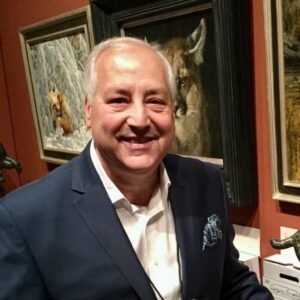
Harold Piazza Jr.
Q: How did you become interested in the American West, and how did you come to reside in Scottsdale?
Even though I’m originally from New Jersey, I’ve always had an interest in the West. My wife Kathleen’s great-grandfather was an Army scout who handled confidential dispatches and was fluent in Apache and Spanish. He owned a ranch in Patagonia, Arizona, in the Tombstone era. There’s a terrific story about him. One day, he helped a young woman cross a river. Not long after, he was asked to visit the chief, an Apache, who presented him with a spectacular pair of moccasins that were not Apache, but Lakota. As it happened, the young woman he had helped cross the river was the chief’s daughter, a princess, if you will. “How did you recognize me?” the marshal asked in Apache. “We knew you by your horse,” the chief replied. “That’s how we tell friend from foe at a distance.” There’s another part to this story that I’ll get to, but I want to say that it was in 2009, when I was attending a conference in Scottsdale, that my wife and I began to look at homes and move towards wintering here.
Q: You and your wife are avid collectors of Western paintings and sculptures. How did you become interested in Western Art?
I’ve collected everything: stamps, coins, paintings, European etchings. Once we were spending more time in Scottsdale, we began to attend gallery exhibitions and auctions. Through the Scottsdale Art Auction, we became friends with Brad and Jinger Richardson and started to do our homework and begin to think about which artists we liked and how to craft a collection. We traveled to other auctions and shows like the Autry.
Q: Who are some of your favorite artists?
Paintings by Bill Anton, Frank McCarthy, Logan Hagege, Mark Maggiori, Don Oelze, Michael Dudash. Oreland Joe and Alvin Marshall’s alabaster carvings, Harry Jackson and Bill Nebeker’s bronzes. We were thrilled to lend a magnificent Nebeker bronze, Season of the Buffalo, to the Phippen Museum for the Nebeker retrospective. After a while—and this might be a good time to close the story of the marshal and the princess—we also became friendly with Brad and Jinger’s daughter, Janell. Kathleen’s mother sold the Lakota moccasins at Skinner Auctions, so Janell helped us commission artist Gayle Nason to do a painting of them in honor of the story and Kathleen’s great-grandfather. That was a really interesting process and great fun.
Q: How did you become a Western Spirit Board Member, and what do you feel you bring to the organization?
Through Brad, I met Jim Bruner and Mike Fox, and in 2019 they asked me to join the Board. I’m a real estate lawyer with business law and marketing experience, so I try to bring an understanding of the museum in the larger context of the neighborhood and city and help come up with ideas to connect the museum with the public.
Q: What are some of your favorite exhibitions and objects in the museum?
The Lewis and Clark exhibition was incredible. Curtis, of course. Paul Calle’s moon landing pieces. Abe Hays’s Western artifacts. One of the real thrills is to see works in a museum by artists you own. There’s Roy Andersen. There’s Logan Hagege. And then to see John Coleman’s Hidatsa—The Greeter, a bronze we ourselves own, on view as part of the Howie Alper exhibition—it’s amazing.
Q: Many people say, “Why art? You could invest that money elsewhere?”
Art gives me interest and dividends. When I look at it, that’s my dividend. You’ll never lose money on beauty. And the joy of collecting with Kathleen—we have to love the work, both of us—that’s another wonderful dividend.
Q: What did you miss when Western Spirit was closed during the pandemic?
I missed hearing the laughter and voices of the children who walk through Western Spirit. Their excitement.
Q: What do you say to people you meet who have never visited Western Spirit?
I consider myself a proactive ambassador. I talk about the museum all the time, to everyone. If someone says, “No, I haven’t been there,” I tell them the museum has both an art perspective and a Western perspective. Spectacular exhibits for people of all ages. Wonderful staff and docents who take pride in telling the stories of the various exhibitions and objects. It usually doesn’t take much enticement to get people to go, or to come back. Western Spirit is all about “we.” Not “I” or “me.” And that shines through to everyone who visits.
Harold serves on the Development, Investment and Marketing Committees for Western Spirit.
